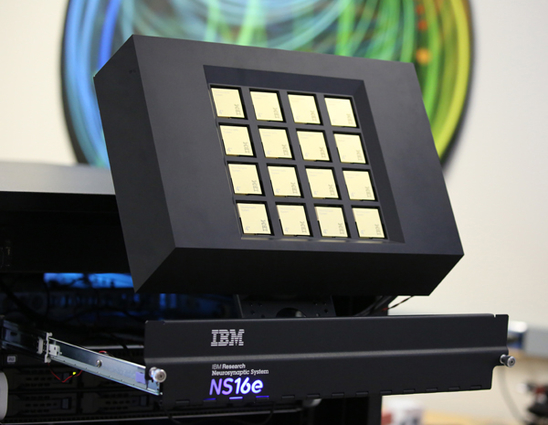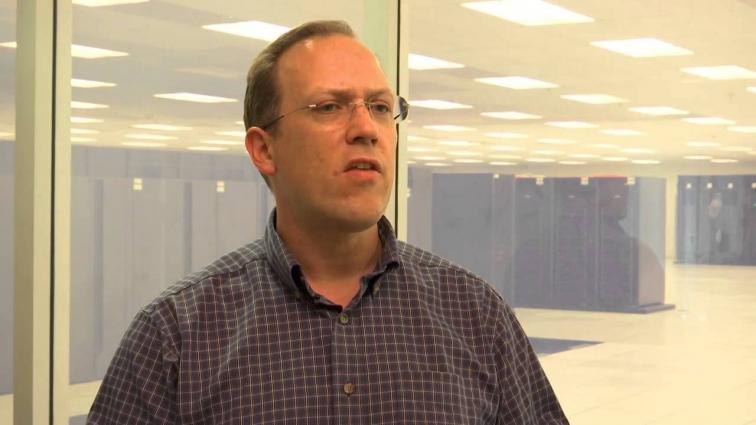Lawrence Livermore and IBM collaborate to build new brain-inspired supercomputer
 (Download Image)
The 16-chip IBM TrueNorth platform Lawrence Livermore will receive later this week. The scalable platform will process the equivalent of 16 million neurons and 4 billion synapses and consume the energy equivalent of a hearing-aid battery – a mere 2.5 watts of power. Photo courtesy of IBM.
(Download Image)
The 16-chip IBM TrueNorth platform Lawrence Livermore will receive later this week. The scalable platform will process the equivalent of 16 million neurons and 4 billion synapses and consume the energy equivalent of a hearing-aid battery – a mere 2.5 watts of power. Photo courtesy of IBM.
Chip-architecture breakthrough accelerates path to exascale computing; helps computers tackle complex, cognitive tasks such as pattern recognition sensory processing
LIVERMORE, Calif. and ARMONK, N. Y. – Lawrence Livermore National Laboratory (LLNL) today announced it will receive a first-of-a-kind brain-inspired supercomputing platform for deep learning developed by IBM Research. Based on a breakthrough neurosynaptic computer chip called IBM TrueNorth, the scalable platform will process the equivalent of 16 million neurons and 4 billion synapses and consume the energy equivalent of a hearing aid battery – a mere 2.5 watts of power.
The brain-like, neural network design of the IBM Neuromorphic System is able to infer complex cognitive tasks such as pattern recognition and integrated sensory processing far more efficiently than conventional chips.
The new system will be used to explore new computing capabilities important to the National Nuclear Security Administration’s (NNSA) missions in cybersecurity, stewardship of the nation’s nuclear weapons stockpile and nonproliferation. NNSA’s Advanced Simulation and Computing (ASC) program will evaluate machine-learning applications, deep-learning algorithms and architectures and conduct general computing feasibility studies. ASC is a cornerstone of NNSA’s Stockpile Stewardship Program to ensure the safety, security and reliability of the nation’s nuclear deterrent without underground testing.
"Neuromorphic computing opens very exciting new possibilities and is consistent with what we see as the future of the high performance computing and simulation at the heart of our national security missions," said Jim Brase, LLNL deputy associate director for Data Science. "The potential capabilities neuromorphic computing represents and the machine intelligence that these will enable will change how we do science."
The technology represents a fundamental departure from computer design that has been prevalent for the past 70 years, and could be a powerful complement in the development of next-generation supercomputers able to perform at exascale speeds, 50 times (or two orders of magnitude) faster than today’s most advanced petaflop (quadrillion floating point operations per second) systems. Like the human brain, neurosynaptic systems require significantly less electrical power and volume.
"The low power consumption of these brain-inspired processors reflects industry’s desire and a creative approach to reducing power consumption in all components for future systems as we set our sights on exascale computing," said Michel McCoy, LLNL program director for Weapon Simulation and Computing.
"The delivery of this advanced computing platform represents a major milestone as we enter the next era of cognitive computing," said Dharmendra Modha, IBM fellow and chief scientist of Brain-inspired Computing, IBM Research. "We value our partnerships with the national labs. In fact, prior to design and fabrication, we simulated the IBM TrueNorth processor using LLNL’s Sequoia supercomputer. This collaboration will push the boundaries of brain-inspired computing to enable future systems that deliver unprecedented capability and throughput, while minimizing the capital, operating and programming costs – keeping our nation at the leading edge of science and technology."
A single TrueNorth processor consists of 5.4 billion transistors wired together to create an array of 1 million digital neurons that communicate with one another via 256 million electrical synapses. It consumes 70 milliwatts of power running in real time and delivers 46 giga synaptic operations per second – orders of magnitude lower energy than a conventional computer running inference on the same neural network. TrueNorth was originally developed under the auspices of the Defense Advanced Research Projects Agency’s (DARPA) Systems of Neuromorphic Adaptive Plastic Scalable Electronics (SyNAPSE) program, in collaboration with Cornell University.
Under terms of the $1 million contract, LLNL will receive a 16-chip TrueNorth system representing a total of 16 million neurons and 4 billion synapses. LLNL also will receive an end-to-end ecosystem to create and program energy-efficient machines that mimic the brain’s abilities for perception, action and cognition. The ecosystem consists of a simulator; a programming language; an integrated programming environment; a library of algorithms as well as applications; firmware; tools for composing neural networks for deep learning; a teaching curriculum; and cloud enablement.
Lawrence Livermore computer scientists will collaborate with IBM Research, partners across the Department of Energy complex and universities to expand the frontiers of neurosynaptic architecture, system design, algorithms and software ecosystem.
About Lawrence Livermore National Lab
Founded in 1952, Lawrence Livermore National Laboratory (www.llnl.gov) provides solutions to our nation’s most important national security challenges through innovative science, engineering and technology. Lawrence Livermore National Laboratory is managed by Lawrence Livermore National Security, LLC for the U.S. Department of Energy's National Nuclear Security Administration.
Laboratory news releases and photos are also available on the Web.
About IBM Research
Now in its 71st year, IBM Research continues to define the future of information technology with more than 3,000 researchers in 12 labs located across six continents. Scientists from IBM Research have produced six Nobel Laureates, 10 U.S. National Medals of Technology, five U.S. National Medals of Science, six Turing Awards, 19 inductees in the National Academy of Sciences and 20 inductees into the National Inventors Hall of Fame. For more information, visit the Web.
For more information about IBM, visit the website,IBM Accessibility and IBM's University Relations programs.
Related Links
Caroline Yu Vespi/IBM Media Relations (408) 927-2205Brain-inspired supercomputer video
IBM Blog
IBM
Advanced Simulation and Computing
National Nuclear Security Administration
Tags
HPC, Simulation, and Data ScienceComputing
Science
Featured Articles








